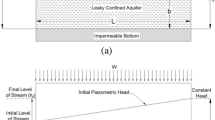Abstract
A novel definition of the concept of derivative with fractional order was introduced. To further enhance the mathematical model describing the flow of water within a leaky aquifer, we apply the novel derivative. The resulting equation was solved with three different methods. We presented some numerical simulations to show the efficiency of the used derivative.





Similar content being viewed by others
References
Atangana A (2016) On the new fractional derivative and application to nonlinear fisher's reaction-diffusion equation. Appl Math Comput 273:948–956
Barker JA (1988) A generalized radial flow model for hydraulic tests in fractured rock. Water Resour Res 24(10):1796–1804
Benson DA, Wheatcraft SW, Meerschaert MM (2000) Application of a fractional advection-dispersion equation. Water Resour Res 36(6):1403–1412
Berkowitz B, Cortis A, Dentz M, Scher H (2006) Modeling non-fickian transport in geological formations as a continuous time random walk. Rev Geophys vol. 44, no. 2, Article ID RG2003, pp 22-30
Caputo M (1967) Linear models of dissipation whose Q is almost frequency independent, part II. Geophys J Int 13(5):529–539
Caputo M, Fabrizio M (2015) A new definition of fractional derivative without singular kernel. Prog Fract Differ Appl 1(2):73–85
Hantush MS (1961a) Drawdown around a partially penetrating well. J Hyd Div Proc Am Soc Civil Eng vol. 87, no. HY4, pp 83–98
Hantush MS (1961b) Aquifer tests on partially penetrating wells. J Hyd Div Proc Am Soc Civil Eng vol. 87, no. HY5, pp 171–19
Losada J, Nieto JJ (2015) Properties of a new fractional derivative without singular kernel. Prog Fract Differ Appl 1(2):87–92
Moench AF (1984) Double-porosity models for a fissured groundwater reservoir with fracture skin. Water Resour Res 20(7):831–846
Podlubny I (2002) Geometric and physical interpretation of fractional integration and fractional differentiation. Fractional Calc Appl Anal 5(4):367–386
Ramey HJ (1982) Well-loss function and the skin effect: a review. In: Narasimhan TN (ed) Recent trends in hydrogeology. Geol Soc Am special paper 189, pp. 265–271
Rorabaugh MJ (1953) Graphical and theoretical analysis of step-drawdown test of artesian well. Proc Am Soc Civil Eng vol. 79, separate no. 362, 23pp
Theis CV (1935) The relation between the lowering of the piezometric surface and the rate and duration of discharge of a well using groundwater storage. Am Geophys Union Trans 16:519–524
Author information
Authors and Affiliations
Corresponding author
Rights and permissions
About this article
Cite this article
Atangana, A., Alkahtani, B.S.T. New model of groundwater flowing within a confine aquifer: application of Caputo-Fabrizio derivative. Arab J Geosci 9, 8 (2016). https://doi.org/10.1007/s12517-015-2060-8
Received:
Accepted:
Published:
DOI: https://doi.org/10.1007/s12517-015-2060-8




